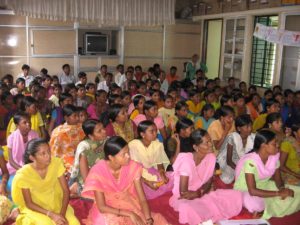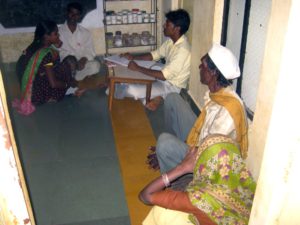Tribal belt of Gujarat adjoining Maharashtra is a difficult terrain. Tribal settled in forestry areas have poor access to almost all basic services including medical care. Whatever little health care that reaches from government primary care is inadequate to meet their needs. People often seek medical care from private sectors in towns like Dharampur and Kaparada. This results in unnecessarily high costs of travel and exorbitant fees for even common sicknesses.

To address the health care needs ARCH initiated training Village Health Workers (VHWs) based on ‘Barefoot Doctors’ approach developed in China and Cuba. Till now ARCH has trained 40 Village Health Workers (VHWs) from 25 villages serving a population of around 40,000 located in two clusters of Vavar (16 villages) and Mamabhacha (10 villages) at a distance of 60 km from Dharampur. Guided by the local needs assessment and epidemiology of prevalent diseases the training programme for VHWs was developed. The training is given in a stepwise manner building their knowledge and skills in diagnosing and provide treat of common illnesses like diarrhoea, malaria, anaemia, pneumonia, and skin infections. VHWs are also trained in identifying people who could benefit by timely referrals at our dispensary in Dharampur or specialists hospitals in the area. The free medicine supplies and treatment at door step is reducing suffering from preventable illnesses and savings travel cost for the communities. As the village workers come from the same community and are familiar with the local customs they are readily accepted by the communities. This helps in toping up other medical care through mobile camps by visiting specialists. VHWs keep meticulous records to continually update local epidemiological understanding.
VHWs also support government Maternal and Child Health (MCH) programme to reduce maternal and child mortalities. VHWs trust with community maximise the use of MCH services delivered by visiting nurse from primary care centers. Their skills in identification of ‘at risk’ women and timely referrals to the hospital has prevented many unnecessary deaths during delivery. Similar gains in reducing child mortality are made by their skills in monitoring growth of children under two.
Tightly supervised and supported the VHWs have become the backbone of the community health program. Health workers receive a modest stipend for their work. The additional monetary incentive is given for extra workloads such as home visits to pregnant & lactating women and babies, taking children for immunizations, or health & nutrition awareness program etc.
Over a period the VHWs training has evolved to address queries that VHWs raised during their monthly meetings so that their abilities best reflect the medical situations they face in their villages. ARCH’s training programme is accepted by other NGOs working with tribal population in Dharampur and Kaparada areas. ARCH assisted these NGOs by training about 600 additional workers employed by them.
